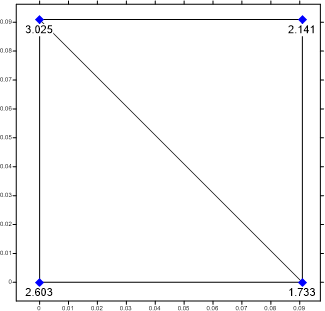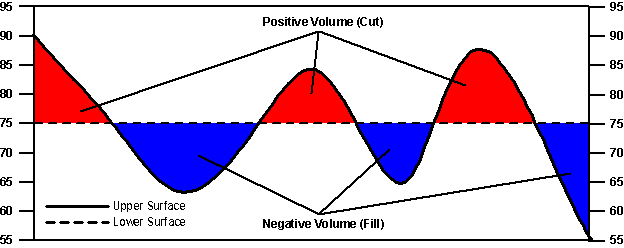Cut and Fill Volumes
The Cut & Fill Volumes section of the Grid Volume Report displays the Positive Volume (Cut) and the Negative Volume (Fill). The cut portion is the volume between the upper and lower surface when the upper surface is above the lower surface. The fill portion is the volume between the upper and lower surfaces when the upper surface is below the lower surface.
Calculating Cut and Fill Volumes
The Cut & Fill Volumes section uses a different calculation technique than the three methods used to define the volume, Extended Trapezoidal Rule, Extended Simpson's Rule, and Extended Simpson's 3/8 Rule. For determining cut and fill volumes, first the lower surface grid values are subtracted from the upper surface grid values. This normalizes the Z values where positive values indicate the upper surface is above the lower surface and negative values indicate the upper surface is below the lower surface.
Next each grid cell is split into two triangles. For example the grid cell defined by the first row and first column of the grid file would be split into the following triangles in grid coordinates (row, column): one triangle is Z(0,0), Z(1,0), and Z(0,1) while the other is Z(1,0), Z(0,1), and Z(1,1).
|
|
|
The grid cell is split into two triangles. |
The triangles are compared to a horizontal plane at Z=0. This generates triangular prisms between the calculated surface and the horizontal plane. Some prisms are completely above the horizontal plane. These prisms occur where all three Z values for the upper surface are greater than the values for the lower surface. This leads to a positive volume or cut. Some prisms are completely below the horizontal plane. These prisms occur where all three Z values for the upper surface are less than the values for the lower surface. This leads to a negative volume or fill. Finally some prisms intersect the horizontal plane. This leads to one prism with a quadrilateral base and one prism with a triangular base, where one prism is a positive (cut) volume and one is a negative (fill) volume. The quadrilateral prism is between two points on the same side of the Z=0 plane. The triangular prism is opposite the quadrilateral prism.
|
|
|
Prisms are created from the net grid values and the horizontal planar surface at Z=0. The red prisms above are positive (cut) volumes. The blue prisms are negative (fill) volumes. |
Finally, the volumes are calculated for all the positive (cut) prisms and summed, and the volumes are calculated for all the negative (fill) prisms and summed. Finally, the net volume is the difference between the cut and fill volumes.
NoData regions on either the upper or lower surface are excluded from consideration during the cut and fill calculations.
Net Volume
The net volume is the positive, or cut, volume minus the negative, or fill, volume. To visualize net volume, consider a construction site where the topography must be graded to a flat surface prior to the beginning of construction. The upper surface represents the current topography, and the lower surface represents the final graded site elevations. In some places, cut must be made into the current topography to remove earth to the level of the final site. In other areas, earth may be needed to fill in areas where the current topography is below the elevation of the final site. The net volume is the difference between all cuts and all fills. If the volume is positive, earth needs to be removed from the site to achieve the final level. If the volume is negative, earth needs to be hauled into the site to achieve the final planned grade for the site.
|
|
|
Cross-section showing the relation between the upper and lower surfaces, and the cut and fill volumes. The lower surface is defined by Z=75. |
Example
You can determine the volume of a pond for which you have generated a grid file. You can define the grid file of the pond bottom as the upper surface, and use a plane set at the level of the surface of the pond as the lower surface. The volume of the pond is the Negative Volume (Fill) in the Cut & Fill Volumes section of the Grid Volume Report.


